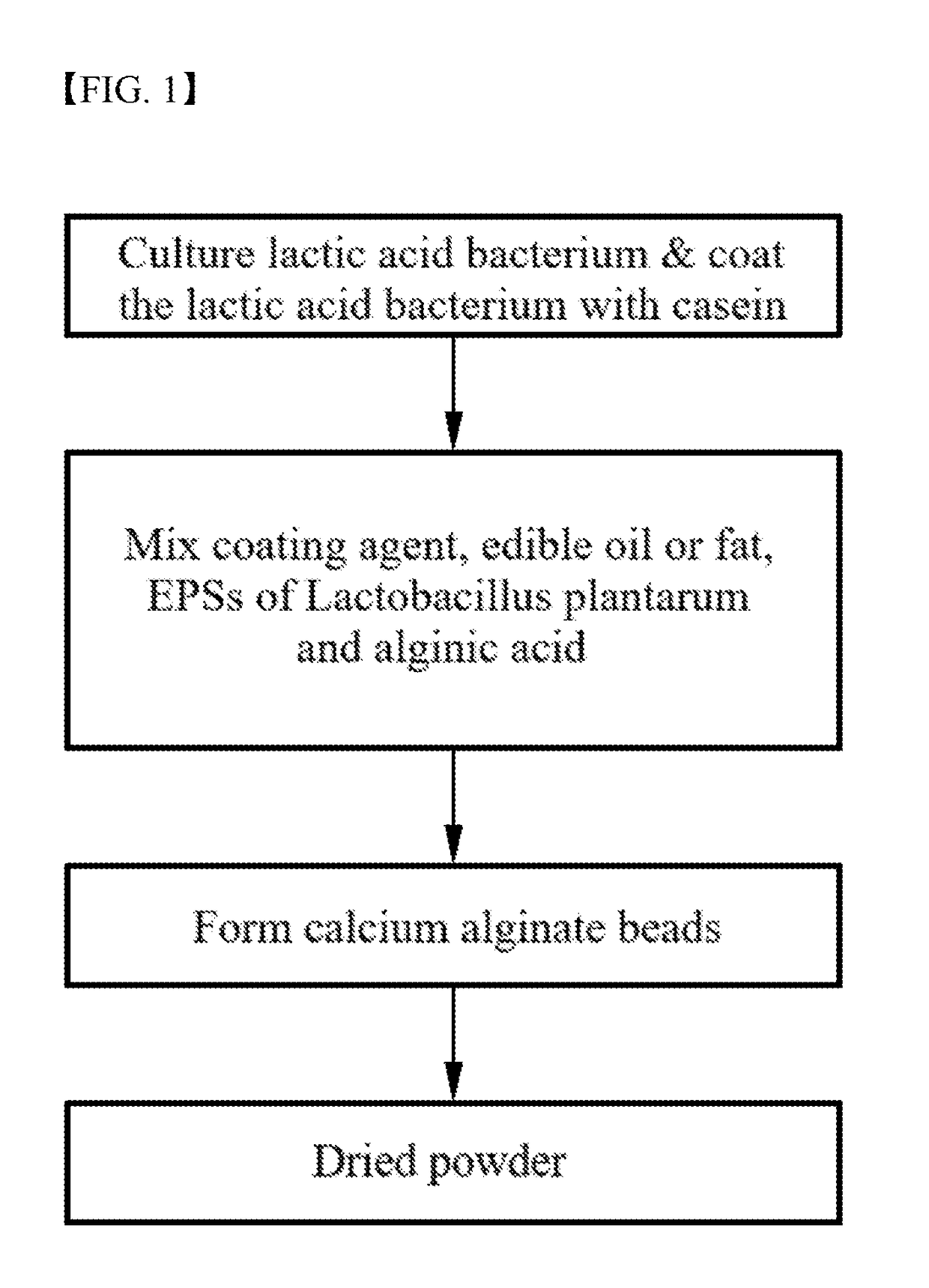Coating method of lactic acid bacteria with increased intestinal survival rate
a technology of lactic acid bacteria and coating method, which is applied in the field of coating method lactic acid bacterium complex, can solve the problems that lactic acid bacteria processed into powders or capsules are likely to be killed during long-term storage, and achieve the effect of improving storage stability and intestinal survival of lactic acid bacterium
- Summary
- Abstract
- Description
- Claims
- Application Information
AI Technical Summary
Benefits of technology
Problems solved by technology
Method used
Image
Examples
example 1
Preparation of Lactic Acid Bacterium-Containing complex
[0060]Lactobacillus plantarum CJLP243 was cultured in MRS liquid medium (Difco, USA) supplemented with 0.02 wt % of defatted milk at 37° C. for 18 to 24 hours. The culture was centrifuged. The supernatant was discarded and only the casein-coated lactic acid bacterium was collected.
[0061]Thereafter, about 15 wt % of trehalose as a cryoprotectant, about 15 wt % of maltodextrin as a coating agent, about 4 wt % of defatted milk, about 0.01 wt % of xanthan gum as another coating agent, and 2 wt % of fructooligosaccharide as a prebiotic relative to the weight of the bacterium were mixed together. Water was added to the mixture and sterilized. The collected lactic acid bacterium was mixed with the sterilized solution and the mixture was suspended.
[0062]Then, 2 wt % of sodium alginate was dissolved in water to prepare an alginic acid solution. The suspension was mixed with the alginic acid solution in amounts such that the ratio of the ...
experimental example 1
Evaluation of Intestinal Survival
[0075]Lactic acid bacteria are likely to be killed by various environmental factors in the digestive organs after being eaten. The most important factors are gastric acid from the stomach and bile acid from the duodenum. Specifically, gastric acid directly acts on bacteria to induce their death due to its strong acidity. Bile acid is involved in the killing of bacteria due to the presence of various digestive enzymes (mainly lipases) or the stress of osmotic pressure. A simple model method for evaluating the survival of living bacteria against gastric acid / bile acid is the simulated stomach duodenum passage (SSDP) test proposed by M. G. Vizoso Pinto, C. M. A. P. Franz, U. Schillinger, and W. H. Holzapfel in “Lactobacillus spp. with in-vitro prebiotic properties from human faeces and traditional fermented products,” International Journal of Food Microbiology, vol. 109, no. 3, pp. 205-214, 2006. According to a major SSDP test, a predetermined concentra...
PUM
 Login to View More
Login to View More Abstract
Description
Claims
Application Information
 Login to View More
Login to View More - R&D
- Intellectual Property
- Life Sciences
- Materials
- Tech Scout
- Unparalleled Data Quality
- Higher Quality Content
- 60% Fewer Hallucinations
Browse by: Latest US Patents, China's latest patents, Technical Efficacy Thesaurus, Application Domain, Technology Topic, Popular Technical Reports.
© 2025 PatSnap. All rights reserved.Legal|Privacy policy|Modern Slavery Act Transparency Statement|Sitemap|About US| Contact US: help@patsnap.com

